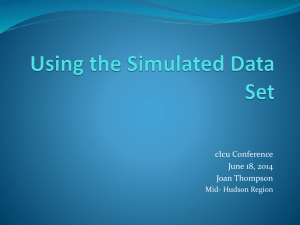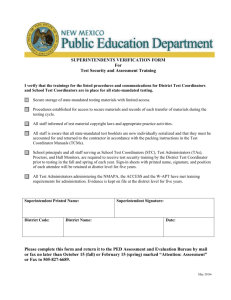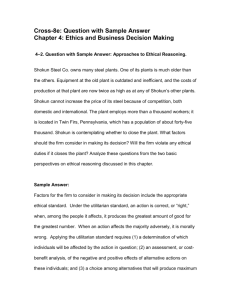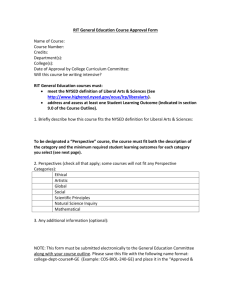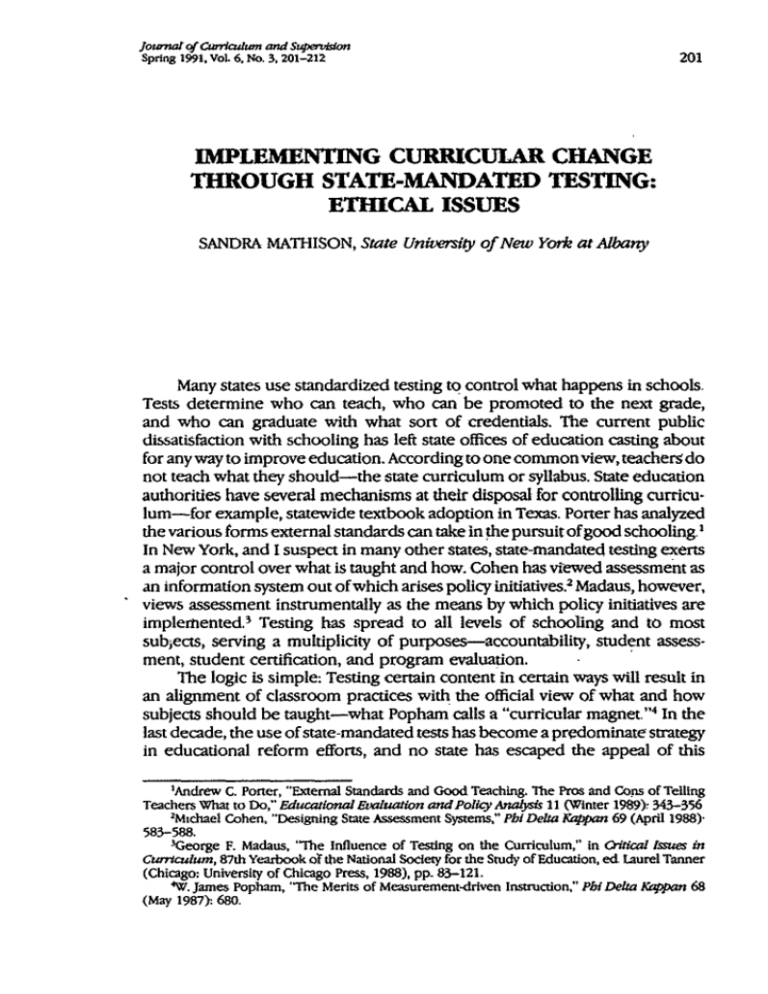
JouWnaofCiculwn
and Supm'vWon
Spring 1991, Vol. 6, No. 3, 201-212
201
IMPLEMENTING CURRICULAR CHANGE
THROUGH STATE-MANDATED TESTING:
ETHICAL ISSUES
SANDRA MATHISON, State University of New Yot*rk at Albany
Many states use standardized testing to control what happens in schools.
Tests determine who can teach, who can be promoted to the next grade,
and who can graduate with what sort of credentials. The current public
dissatisfaction with schooling has left state offices of education casting about
for any way to improve education. According to one common view, teachers do
not teach what they should-the state curriculum or syllabus. State education
authorities have several mechanisms at their disposal for controlling curriculum-for example, statewide textbook adoption in Texas. Porter has analyzed
the various forms external standards can take in the pursuit of good schooling.'
In New York, and I suspect in many other states, state-mandated testing exerts
a major control over what is taught and how. Cohen has viewed assessment as
an information system out of which arises policy initiatives. 2 Madaus, however,
views assessment instrumentally as the means by which policy initiatives are
implemented. 3 Testing has spread to all levels of schooling and to most
subjects, serving a multiplicity of purposes-accountability, student assessment, student certification, and program evaluation.
The logic is simple: Testing certain content in certain ways will result in
an alignment of classroom practices with the official view of what and how
subjects should be taught-what Popham calls a "curricular magnet." 4 In the
last decade, the use of state-mandated tests has become a predominate strategy
in educational reform efforts, and no state has escaped the appeal of this
'Andrew C. Porter, "External Standards and Good Teaching. The Pros and Cons of Telling
Teachers
What to Do," EducationalEvaluation andPolicyAnalys 11 (Winter 1989): 343-356
2
Michael Cohen, "Designing State Assessment Systems," PbiDelta Kapan 69 (April 1988)
583-588.
'George F. Madaus, "The Influence of Testing on the Curriculum," in Critical ssues in
Curriculum,87th Yearbook o the National Society for the Study of Education, ed Laurel Tanner
(Chicago: University of Chicago Press, 1988), pp- 83-121.
'W. James Popham, "The Merits of Measurement-driven Instruction," Pbi Delta IOppan 68
(May 1987): 680.
202 202
State-mandated
SMWt-mandated Testing:
Testing. Atbical
Ethicalissues
Issues
popular means for improving education.' So, for example, the recently implemented New York state-mandated 4th grade science program evaluation test
will ensure that science is taught, and taught in a certain way. The same is true
in social studies, which is now tested at 6th and 8th grades in New York State.
Although implementing these tests may cause great anxiety for students and
school personnel and, in fact, may be inefficient in attaining the intended outcomes, the state still uses the policy-implementation strategy. The end justifies
the means, even when the means do not produce the desired ends perfectly.
The effects of testing are for the most part clearly understood, although
we might well disagree about,the valuation of these various effects. Madaus
outlines the influence of standardized achievement testing in the following
seven principles:
Prhn2cte 1. The power of tests and examinations to affect individuals, Institutions,
curriculum, or instruction is a perceptual phenomenon. If students, teachers, or
administrators believe that the results of an examination are important, it matters very
little whether this is really true or false-the effect is produced by what individuals
perceive to be the case.
Princtpe 2. The more any quantitative social indicator is used for social decision
making, the more likely it will be to distort and corrupt the social processes it is
intended to monitor.
Prfncple 3. If important decisions are presumed to be related to test results, then
teachers will teach to the test.
Princ/Ie4. In every setting where a high-stakes test operates, a tradition of past exams
develops, which eventually de facto defines the curriculum.
Princple 5. Teachers pay particular attention to the form of questions on a high -stakes
test (for example, short answer, essay, multiple-choice) and adjust their instruction
accordingly.
Principle6. When test results are the sole or even partial arbiter of future educational
or life choices, society tends to treat test results as the major goal of schooling rather
than as a useful but fallible indicator of achievement
Princple7. Ahigh-stakes test transfers control over the curriculum to the agency which
sets or controls the exam.6
Policymakers, school administrators, and teachers understand these principles
well, even if not everyone in these roles would so define the effects of testing.
The purpose of this article is to explore the ethical issues involved in
using standardized testing to implement a state-level policy. The context is
New York State, which has a long history of using such a strategy, the best
example being the Regents examinations. Beginning with grade 3, there is at
least one state-mandated test, and often more, during each year of schooling.
'Peter w. Airasian, "Symbolic Validation. The Case of State-mandated, High-Stakes Testing,"
Educational Ealuarionand Polkcy Anay 10 (Winter 1988): 301-313.
'George F. Madaus, "The Influence of Testing on the Curriculum," in Critical Issues in
Curricudum,87th Yearbook of the National Society for the Study of Education, ed Laurel Tanner
(Chicago: University of Chicago Press, 1988), pp. 88-98 passim.
SandraMatbison ?MkJ Matbison
203
203
The specific example in this article is the 4th grade science program evaluation
test, which was administered in New York State for the first time in spring
1989. The Bureau of Science in the New York State Education Department
(NYSED) implemented a state syllabus in 1985 that outlines the focus of the
curriculum. The syllabus is a nonspecific document that does not prescribe
activities, textbooks, or teaching strategies. Rather, it generally states goals to
be achieved in science education. As we might imagine, a document of this
sort is likely to have little effect on what sort of science gets taught. In fact,
many teachers are unfamiliar with the state syllabus in science and in most
other subjects, as well. The bureau's frustration with effecting change in
science education across the state led eventually to the development of the
Elementary Science Program Evaluation Test (ESPET), administered at
grade 4, primarily because no state-mandated test was administered at this
one grade, although some people also argue that the syllabus has a natural
break at this point.
In this context, I discuss ethical issues, but a word of caution is necessary
I believe the people working in the Bureau of Science, and other NYSED
personnel, act in ways they believe are in the best interests of schools, teachers,
and students. The deleterious effects of their actions are not a product of their
evil intentions or neglect. I believe the ethical principles inherent in actions
are embedded in the institutional structures within which people operate
Although the Bureau of Science and others in the NYSED should be held
accountable for. their choices, it is not a simple matter of finger pointing and
blame laying. All policies and the strategies for implementing the policies
should be exposed to ethical critique, with the goodness and rightness of
positions challenged and justified. Ethical critique is particularly necessary for
actions taken by public institutions on behalf of the public and in its interests.
THE POLICY OF THE NYSED BUREAU OF SCIENCE
The Bureau of Science's policy is directed toward accomplishing two
goals. to increase the amount of science taught in the elementary schools of
New York and to use a hands-on inquiry approach to teaching science. These
goals are reflected in the New York State Elementary Science Syllabus in place
since 1985. The Bureau of Science has monitored the implementation of the
state syllabus, and although some change has occurred in classrooms, NYSED
staff believe it is too little and does not respond to the general public's
demands to immediately improve science education.
Any full critique of the ethical issues inherent in using the ESPET would
necessarily raise questions about the worthiness of these goals. Are the stated
goals and intents of the policy defensible, and on what grounds? For the
purposes of this article, I will leave aside this discussion, not because it is
unimportant,but because of the consensus on the worthiness ofthegoals. With
few exceptions, people believe more science should be taught to elementary
204 204
State-mandated Testing;
State-mandated
Testing.Ethical
Eirbcal f.uues
Issties
students and that using a hands-on manipulative approach to teaching is
appropriate. Intersubjective agreement alone does not make these goals wor
thy, but it does make the goals compelling and motivates efforts to implement
the policy. We need to raise questions about the worthiness of this policy, if
it is unjustifiable, it may misdirect educational effort and resources. For the
purposes of the rest of this discussion, I assume that teaching more science
in elementary schools using a hands-on approach is worthwhile.
The ESPET was written into the Regents Action Plan, a document that
directs New York schools by recommending and mandating certain actions
and by clarifying the meaning of the terms in the Commissioner's Regulations
The Regents Action Plan defines the purpose of the ESPET as a means
to measure the effectiveness of school programs in the elementary grades and
to measure student progress in those skills where evaluation of student perfor
mance requires techniques other than written examinations Emphasis will be
placed on evaluating laboratory work, oral expression, critical thinking, and problemsolving skills.
The ESPET was designed to assess content knowledge, inquiry skills,
attitudes toward science, and school environmental factors that affect science
education. The NYSED mandates only the student-assessment parts of the
evaluation, the attitudinal and environmental surveys are optional, to be con
ducted at the discretion and cost of local districts. The decision to mandate
only the student-assessment parts was a compromise made with the NYSED
Bureau of Testing personnel who believed the attitudinal and environmental
measures were too "soft" and consequently psychometrically and legally
indefensible.
The student-assessment parts of the ESPET were designed to explicitly
direct teacher time and effort in certain ways. The test consists of two parts
a 45-item objective test (29 items focus on knowledge and 16 on skills) and
a 17-item manipulative test. The objective test is a familiar multiple-choice
test, but the Bureau of Science is proudest of the manipulative part for its
progressiveness and authenticity. The manipulative part consists of five stations with clearly specified tasks intended to assess students' abilities to measure, to observe and predict, to interpret data, to classify, to generalize,
and to make inferences. The form of the test was explicitly chosen to
direct teachers' attention to specific content contained in the state syllabus
and to encourage teachers to use a hands-on experimental approach to
teaching science.
THE NYSED TELEPHONE GAME
The ESPET is not what the Regents Action Plan says it is. I am reminded
of the Telephone Game we played as children at birthday parties. One person
whispers a phrase in a neighbor's ear, and in turn that person whispers in his
or her neighbor's ear, and so on, when the last person repeats the phrase
SandraMaison SandnzMatbison
205
205
aloud, it is significantly altered from what the first person said. So too does
the ESPET go through several interpretations, coming out sounding much
different from what the Regents Action Plan says. In essence, the program
evaluation test (which is actually a misnomer because the "test" is a formative
process involving several types of data collection from several sources with
specified reporting structures that focus on Strengths and weaknesses in the
curriculum and school environment) has come to be seen as the same as the
student assessment given in grades 3 and 6--the Pupil Evaluation Program
(PEP). This perception is partly so because the state mandates only the studentassessment parts of the ESPET, all other data collection is optional and done
at the discretion of individual school districts. Some districts undoubtedly will
implement the whole program evaluation, but most will not. Although the
NYSED supplies all the materials needed for student testing, local districts must
bear the cost of administering and analyzing the attitudinal and environmental
surveys. Although it may not be substantial, the cost is significant for many
districts. Also, the simple cost in time, instructional and administrative, works
against full implementation. To date, the NYSED does not have a record of
the number of districts implementing the total evaluation program, but in
attending meetings with the state network of science mentors, I found apparent resistance to doing so, especially from New York City school districts.
If the purpose of the ESPET is truly to evaluate the elementary science
program, then testing every 4th grader in New York State every year on exactly
the same test items is clearly unnecessary. Some form of matrix sampling
could reduce the data collection and analysis burden and would imply an
emphasis other than simple student assessment, but the NYSED never seriously considered this option. Reporting ESPET results on New York State's
Comprehensive Assessment Report, a sort of report card for the state's school
districts, in much the same fashion as PEP results, has reinforced this perception of the ESPET.
Clearly, the message has become garbled-what began as a comprehensive review of the elementary science curriculum has become one more
state-mandated student achievement test. So, what is the problem with this
reinterpretation? The confusion about the initial message of the ESPETs
meaning is more serious than the confusion created in a party game. If the
various constituencies in New York State accept a strategy like the ESPET
because of its characteristics, and the implementation occurs without those
same characteristics, then the districts and schools have been deceived Even
with no malice or intent to deceive, the consequence is still deception. The
Regents, the NYSED, the Bureau of Science, the Bureau of Testing, and the
schools are all complicitous in this deception Ironically, the Regents initially
'R Darrell Bock and Robert J. Mlsievy, "Comprehensive Educational Assessment for the
States: The Duplex Design," Evaluation Comment (November 1987): 1-16.
206 206
State-mandated
State-mandatred Testing:
Testing. A'tbicai
Etbical Issues
Issties
intended to hold schools more accountable for student achievement by implementing more PEP tests. Although the state may have made more sophisticated
and elaborate plans, schools in New York State ended up with something that
looks a lot like more PEP tests.
The similarity between PEP tests and the ESPET is not without consequence because low PEP scores trigger the public to identify a school as
inadequate, resulting in significant NYSED intervention in the school's operations. Although ESPET results do not have this weight (yet), Madaus's first
principle reminds us that-right or wrong-the perceptions of school personnel are what is relevant.
Something is wrong when the actual strategy for implementing a policy
deviates significantly from the planned strategy and does so in ways that still
accomplish the policy's intents. Perhaps this deviation is natural evolution in
policy implementation. Perhaps the plan for the ESPET was not sincere. No
matter what argument is presented with what rationalizations, it is not
right to say that you will be doing one thing and then to do another Saying
you are doing program evaluation when you are doing student assessment
is not right.
THE UTILITARIAN VIEWPOINT
'The use of state-mandated testing to implement a policy is based on
utilitarianism. As a moral theory, utilitarianism defines rightness as maximizing
the good, which is typically expressed as happiness, pleasure, or utility Maximizing total welfare is important, without concern for the individual or the
distribution of good within the total society. So, for example, if the greatest
total welfare required that a subset of children, let's say physically handicapped
children, not be educated in public schools, then a utilitarian view would hold
that not educating these children is morally right and even required.
Assuming this ethical view, the situation in New York schools before
implementing the ESPET was not perceived to maximize the good In fact,
most people would have, seen the situation as undesirable-not enough
science was being taught to young children, what was taught was dull and
textbook-oriented, and the schools were not producing enough scientists nor
a scientifically literate public. To maximize goodness-teaching more science
using a hands-on approach (the utility measure)-the state developed and
implemented the ESPET. Following this ethical principle, if, in fact, more
science was taught using a hands-on approach after implementing the ESPET,
then the total welfare of New York State would be maximized.
A survey of New York's 4th grade teachers indicates that 68 percent
agreed the ESPET clarified what was to be taught, 69 percent said they were
using more hands-on activities in their science lessons, and about half of the
teachers said they were spending more time teaching science than in previous
Matbison
Sandra MasonSandra
A__
207
years.8 These data suggest that implementing the ESPET has maximized the
good for the total society. Thus, if we assume a utilitarian viewpoint, we can
accurately say that using the ESPET was a right thing to do to encourage
teaching more science using a hands-on approach in elementary schools.
But these were not the only consequences of administering the ESPET:
59 percent of 4th grade teachers thought the ESPET results would be used to
evaluate their teaching, 78 percent believed there was much pressure for
students to do well on the test, but half the teachers thought the ESPET did
not adequately reflect the science curriculum in their schools. Teachers felt
pressure to prepare students to do well on the test, and they prepared students
by teaching what was on the test in the form it was tested. For example, one
station of the manipulative test requires students to test for conductivity using
batteries and a light bulb. With the implementation of the ESPET, most
4th graders will have experience with testing conductivity, at least in the way
it appears on the test.
The manipulative test has created a financial burden for schools and
sometimes even for teachers themselves. For the purpose of testing, schools
are expected to provide the equipment according to explicit specifications
provided by the NYSED. Many schools must also purchase equipment for
instructional purposes. What may seem a minor resource allocation becomes
major if the school simply does not have the resources or is not sufficiently
committed to elementary science education to allocate its resources in this
way. Because 4th grade teachers feel responsible for preparing students for the
ESPET, they will personally purchase equipment and materials that conform to
those required for the test. The extent of this problem is unknown, but at
least in the first year of implementation anecdotal evidence suggests the
problem is not isolated. We might imagine that in the future resources will
be diverted away from something else to support the demands of the ESPET.
Another consequence of the ESPET is the increased testing burden on
both teachers and students. This burden cannot simply be expressed in terms
of testing time but also includes time spent preparing students for the test.
Observations in elementary schools indicated abrupt changes in what science
education was sometime in April, just before the test was administered.
This change in curricular focus is part of what Smith has described as the
9
"natural history of the testing event." The burden of testing needs also to be
expressed in terms of the performance anxiety experienced by students and
teachers. The sort of anxiety associated with high-stakes testing is evident
with the ESPET.
$Sally M. Bauer, Sandra M. Mathison, Eileen Merriam, and Kathleen Toms, 'Controlling
Curricular Change through State mandated Testing. Teachers' Views and Perceptions" (paper
presented at the annual meeting of the American Educational Research Association, Boston,
April91990).
Mary L Smith, "The Role of Testing in Elementary Schools" (unpublished manuscript,
Arizona State University, 1990).
208
208
State-mandated
State-mandlated Testing:
Tagting: Etbical
Mbhical Istues
Imiues
For the moment, most teachers favorably perceive the curriculum
changes that have occurred because of the test. Although they may not like
the authoritarianism implicit in this top-down strategy for curricular change,
they identify it as the most effective way to get teachers to respond. Because
more science is being taught and many teachers are excited by the hands-on
approach, the perniciousness of the ESPET is not yet evident. I would speculate
that in only a-few years, when the test has become the curriculum, teachers
will realize that their authority to make curricular decisions has been seriously
limited. In the face of much talk about teacher professionalism, these teachers
will see their professional judgment eroded by the testing process, a contradiction that Ross more fully describes.10
The ESPET affects more than just teachers' curricular decision making; it
affects their opportunity to identify, for themselves, areas for self-improvement
through professional development. The demands of the ESPET imply that all
4th grade teachers should teach science, and in a certain way. Many teachers
undoubtedly feel ill-prepared to do so-elementary teachers typically identify
science as one of the least important subjects and often do not feel prepared
to teach science. Implementing the ESPET suggests that elementary teachers
need to be reskilled. The NYSED has decided what specific professional
development 4th grade teachers need, although it will provide little institutional support
A strictly utilitarian view, one that the NYSED Bureau of Science essentially
assumes, allows us to ignore these consequences, other than the increased
time spent on science using a hands-on approach. I contend that we can
ignore these consequences only if we consider the quality of life in schools,
for teachers and students, relatively unimportant.
OTHER ETHICAL CONCERNS
Utilitarianism is an ethical view embedded in the institutional structures-the various constituencies involved with the ESPET did not agree or
decide to adhere to these principles. "Utilitarianism, it is often held, was
developed to bring order, consistency, and coherence to our considered
moral judgments."" This ethical imperative coheres with the bureaucratic
structures found in most modern institutions. We must recognize, however,
that this ethical view is not "natural." Clearly, we can think about ethics and
justice in other ways that would entail different actions. I believe that two
important related ethical concerns are missing from the NYSED's utilita'oE. Wayne Ross, "Teacher Receptivity to Centrally Imposed Curriculum Change" (paper
presented at the annual meeting of the American Educational Research Association, Boston,
April1990).
tDavid P. Ericson, "Social Justice, Evaluation, and the Educational System," in Evaluation
andSocidalua
e. Issues in Publc Evaluation,New Directions for Program Evaluation, No 45,
ed. Kermeth A. Sirotnik (San Francisco. Jossey-Bass, 1990), p. 10.
MatJLton
SandraMathison Sandra
209
rian view. the distribution of consequences among constituents and an ethic
of caring.
The Distributionof Consequences among Constituents
Even though a utilitarian view might see that the ESPET enhances the
total welfare, the benefits vary among the constituents affected by the test and
the changes it induces. In particular, I have focused on the consequences
of the testing for teachers. We should judge the rightness of any policyimplementation strategy by how benefits (and harms) are distributed-by
specifying criteria, other than those implied by utilitarianism, for distributing
justice. Shapiro'outlines several alternatives-equality, Pareto optimality,
majority, minimax, and dominance.'2
Rawls presents a more elaborate approach to judge the fairness of
the distribution of benefits.' 3 Essentially, he claims that justice should be
mutually advantageous and is possible under the conditions that lead to
"justice as fairness":
Justice as fairness begins from the idea that the most appropriate conception of justice
for the basic structure of a democratic society is one that its citizens would adopt in
a situation that is fair 4between them and In which they are represented as free and
equal moral persons.'
We must begin from what Rawls calls the original position in which people
are ignorant of their particular circumstances to equalize the bargaining
among people. If this hypothetical situation occurs, Rawls suggests two principles will follow:
1. Each person has an equal right to the most extensive system of equal
basic liberties compatible with a similar system of liberty for all.
2. Social and economic inequalities should be arranged so that they both
benefit the least advantaged, consistent with the just-savings principle, and are
attached to offices and positions open to all under conditions of fair equality
of opportunity.
Using Rawls's theory, an ethical strategy for implementing NYSED science
policy would assume this original position. NYSED personnel, school administrators, teachers, and the public would presumably be equal and shrouded in
a "veil of ignorance." Thus, any strategy chosen Would reflect basic liberties
(e.g., freedom of speech, freedom of person, freedom of property) and would
allow social and economic inequalities only if they benefitted the least advan'Jonathan z Shapiro, "SocialJustice and Educational Evaluationr Normative Implications of
Alternative Criteria for Program Assessment," Educational7beory 34 (Spring 1984): 137-149
"John Rawls, A 7beory ofJustice (Cambridge, MA: Harvard University Press, 1971).
4"JohnRawls, "Kantian Constructivism in Moral Theory. The Dewey Lectures,"Joural of
Pbilosopby 77 (September 1980): 522.
210 210
State-mandated
State mandatedTetting:
Testing:Etbical
E401cal Issues
Issues
taged. Would the ESPET have been the choice of strategies for improving
science education under these principles? Probably not. The strategy causes
teachers anxiety, restructures their work in ways they do not control, and
defines science knowledge in limited particular ways. We can identify deleterious effects for students, as well. We might even consider teachers and students
to be least advantaged, with limited access to positions of authority, in this
situation; in that case, the strategy also violates Rawls's second principle
An Ethic of Caring
Not unrelated to the concern about distributing consequences is the
notion of an ethic of caring:
When this ethical orientation is reflected on and technically elaborated, we find that
it is a form of what may be called relationalethics A relational ethic remains tightly
tied to experience because all its deliberations focus on the human beings involved
in the situation under consideration and their relations to each other A relation is
here construed as any pairing or connection of individuals characterized by some
affective awareness in each. It is an encounter or series of encounters in which the
involved parties feel something toward each other.
One who is concerned with
behaving ethically
strives always to preserve or convert a given relation into a
5
caring relation.'
This ethic of caring entails giving our undivided attention to the needs
of others. In mature relations, the role of caring and being cared for can
be exchanged. This ethic makes sense situationally, not by adhering to any
particular notion of rights or duties. Therefore, dialogue and practice are
important means we use to act ethically toward one another The ethic of
caring is almost entirely missing from the implementation of the ESPET
Applying this ethic would first specify a particular relation toward students, as
well as relations among teachers, between administrators and teachers,
between NYSED and school personnel, and among NYSED personnel Using
the ESPET to improve science education ignores these needs almost entirely
ALTERNATIVE POLICY-IMPLEMENTATION STRATEGIES
I have criticized the use of the ESPET to implement what appear to be
worthwhile changes in science education in New York State I have suggested
that this strategy is based on a utilitarian ethical view and that the view ignores
how the strategy affects different people in different ways, in uncaring ways
Madaus has enjoined those of us critical of testing to suggest "attractive
counterstrategies." For me, an attractive counterstrategy must be conceived
with an eye to the process by which the strategy is arrived at and the consequences for all groups involved, not just some overall sense of welfare So,
'SNel Noddings, Caring. A Feminine Approach to Etbcs and Moral Education (Berkeley
University of California Press, 1984), p. 218.
Matbison
SandraMtbison Sandra
211
I briefly outline a few counterstrategies for improving elementary science
education, although their attractiveness may be disputed
1. The ESPET as originally conceived by the Bureau of Science was a
reasonably well formulated plan for program evaluation. Giving schools the
opportunity to implement the ESPET as designed and without the burden of
publicly reporting student assessment data would encourage formative, locally
useful curriculum evaluation. The NYSED would have to relinquish control
over the monitoring process or to significantly alter the perceptions of school
personnel about the uses of ESPET data.
2. At the least, student assessment should be based on some form of
matrix sampling that would provide ample data for curriculum evaluation and
be less burdensome to students and teachers while providing a broader base
of evaluative information.
3. Elementary science education may need improvement because teachers do not feel comfortable or competent teaching science. If so, then strategies encouraging teache, development would, make sense. These strategies,
however, must be implemented at the local level, teachers should decide what
they need to improve science education. For example, in a particular school,
teachers might decide that a specialist should teach all science classes, and
they would either hire the specialist or retool existing staff to satisfy the need.
Or teachers might decide to infuse science into the rest of the curriculum
(analogous to the whole language approach), and therefore all staff members
would need to make a particular effort. The strategies used would necessarily
vary from situation to situation, but tailoring to particular needs would more
likely contribute to serious, productive improvement in science education.
4. Not every elementary school in New York State has a poor science
education program. Strategies that consider different schools' needs and
desires for assistance in accomplishing the Bureau of Science's goals are costsaving and cost-effective. The money now used to support massive student
testing could be easily diverted to other strategies for improving science
education. Schools wanting assistance might be self-identified, or other measures could be employed. The NYSED would be responsible for providing
resources without deciding beforehand how individual schools would
improve their science programs. The NYSED could provide resources to local
school districts in various ways-grants-in-aid, technical assistance, and paid
professional development leaves.
CONCLUSION
Something like this ESPET example probably exists in any state in some
form. The particulars of the situation may differ, but the ethical concerns
remain constant. A utilitarian view of ethics dominants and thus ignores
the consequences of testing for different constituents and does not heed
fundamental needs to care for one another.
212
State-mandatedTesting: Ettical Issues
The alternative strategies for implementing a policy do not have the
quick-fix appeal of student achievement testing. They are not administratively
simple, nor uniform, nor as cost-efficient. But the damage done to schooling,
teachers, and students far outweighs these qualities. In the name of fairness
and justice, we must begin to truly see teachers as professionals who can and
do serve the interests of students.
SANDRA MATHISON is Assistant Professor of Educational Theory and Practice,
School of Education, Education 122, State University of New York at Albany, Albany,
NY 12222.
Vandenberg, Donald Education as a Human Right. A Tbeory of Curriculum
and Pedagogy.New York; Teachers College Press, 1990. 269 pp. $34.95.
The author traces the philosophical roots of the contemporary moral crisis
(nihilism) and argues the place in the school's curriculum of both deontological
and theological ethics. The first five chapters on value and moral education
conclude with an explication of a human rights ethic as a basis for' the structure
of curriculum. The last five chapters focus on an interpretative, normative theory
of curriculum and pedagogy. Throughout (he book, the author analyzes, critiques, and synthesizes the work of dozens of leading theorists Hls own theory
has multiple perspectives on common general education that draws on features
from Spencer, Dewey, Peters, Broudy, and Green. Chapter 9, "knowledge in
Education," proposes a unique seven-strand curriculum of the arts, crafts, and
trades; sports and the dance; natural sciences; social sciences; hupanities; reading; and mathematics.
Cornbleth, Catherine. Curriculum in Context. New York: Falmer Press, 1990
210 pp. $47.00/$22.00.
The author presents curriculum from a critical perspective and as a contextual
social process. This process includes interactions among knowledge, the total
atmosphere of the educational setting, and teachers and students, In addition,
the author urges that we not view curriculum as an isolated construct apart from
its sociocultural and multidimensional contexts of community, state, and national control.
-Therese Ream
Spodeck, Bernard, and Olivia N. Saracho, eds.EarlyChildboodTeacher Prparation. New York: Teachers College Press, 1990. 24 0 pp. $42.95/19.95.
This collection of articles on curriculum and other topics related to early childhood teacher education provides a comprehensive overview of content, pedagogy, historical foundations, research base, reforms,' professional standards,
teacher recruitment and retention, programs outside the United States, current
issues, and prospects for the future.
Copyright © 1991 by the Association for Supervision and Curriculum
Development. All rights reserved.

